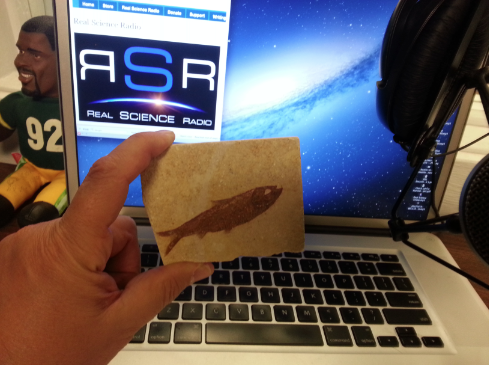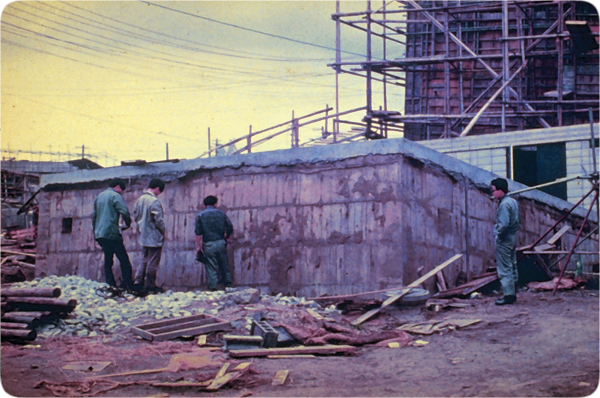Liquefaction Made Most of the Paper Thin Fossils
This is the show from Friday February 8th, 2013
SUMMARY:

* How Did Millions of Fish Get Squished Flat? In this special edition of Real Science Radio, Kevin Lea, with his great knowledge of earthquakes, talks with Bob Enyart about a significant effect of earthquakes and strong tectonic activity: liquefaction. Pastor Lea of Calvary Church, Port Orchard, Washington, and Bob use Dr. Walt Brown's book In the Beginning as a guide to understand the worldwide effects that resulted from when the fountains of the great deep broke forth in the global flood.
* The "Law of Superposition" Is Wrong: As a general description of the world's sedimentary layers, this alleged natural "law" wrongly claims that, "Sedimentary layers are deposited in a time sequence, with the oldest on the bottom and the youngest on the top." In reality, a tremendous amount of sorting of minerals and fossils occurred underground when the continents' mile-deep sediments were first deposited.

* What is Liquefaction: See the formerly buried concrete structure above, which floated up during a Japan earthquake. Walt Brown quotes geologist Arthur Strahler, from book, Physical Geology, "These water-saturated deposits often experience a change in property known as liquefaction when shaken by an earthquake. The material loses strength to the degree that it becomes a highly fluid mud..." Kevin reports that after a recent Washington earthquake, geologists asked residents to report any sightings of mud flowing out of the ground so that they can better understand the dynamics of liquefaction.
* Flat Gaps in Strata Around the World: On the world's continents there are beautifully uniform and flat boundaries between sediments over hundreds of thousands of square miles around the globe. To a significant degree, these flat boundaries between strata are the result of the sorting after burial of minerals, vegetation (coal seams), and animal fossils.

* Bob and Kevin Disccus Liquefaction Effects: Today's RSR program discusses the tectonic effects that occurred for months after the global flood, which sorted sediments worldwide, and also created plumes, mounds, the so-called geologic column, the extraordinary purity of enormous layers of strata, extremely well defined boundaries, cyclothems of repeating patterns of layers that include coal seams (going upward: coal, sandstone, shale, limestone, clay, finer clay; with the whole pattern repeating vertically sometimes dozens of times), and much of the characteristics of fossil-bearing strata. Noah's flood helps to explain the hundreds of thousands of square miles of sediments, with similar strata spanning, and even crossing over to other, continents.
Today's Resource: You can help us stay on the air by purchasing the Real Science Radio Collection, a handy set of MP3 CDs with all of our shows from 2006 to 2011. Also, you can enjoy Bob Enyart’s entertaining and insightful videos each month, mailed to you automatically, simply by subscribing to the BEL Monthly Topical Videos service! And please check out our other great BEL subscription services!
This is the show from Friday February 8th, 2013
SUMMARY:

* How Did Millions of Fish Get Squished Flat? In this special edition of Real Science Radio, Kevin Lea, with his great knowledge of earthquakes, talks with Bob Enyart about a significant effect of earthquakes and strong tectonic activity: liquefaction. Pastor Lea of Calvary Church, Port Orchard, Washington, and Bob use Dr. Walt Brown's book In the Beginning as a guide to understand the worldwide effects that resulted from when the fountains of the great deep broke forth in the global flood.
* The "Law of Superposition" Is Wrong: As a general description of the world's sedimentary layers, this alleged natural "law" wrongly claims that, "Sedimentary layers are deposited in a time sequence, with the oldest on the bottom and the youngest on the top." In reality, a tremendous amount of sorting of minerals and fossils occurred underground when the continents' mile-deep sediments were first deposited.

* What is Liquefaction: See the formerly buried concrete structure above, which floated up during a Japan earthquake. Walt Brown quotes geologist Arthur Strahler, from book, Physical Geology, "These water-saturated deposits often experience a change in property known as liquefaction when shaken by an earthquake. The material loses strength to the degree that it becomes a highly fluid mud..." Kevin reports that after a recent Washington earthquake, geologists asked residents to report any sightings of mud flowing out of the ground so that they can better understand the dynamics of liquefaction.
* Flat Gaps in Strata Around the World: On the world's continents there are beautifully uniform and flat boundaries between sediments over hundreds of thousands of square miles around the globe. To a significant degree, these flat boundaries between strata are the result of the sorting after burial of minerals, vegetation (coal seams), and animal fossils.

* Bob and Kevin Disccus Liquefaction Effects: Today's RSR program discusses the tectonic effects that occurred for months after the global flood, which sorted sediments worldwide, and also created plumes, mounds, the so-called geologic column, the extraordinary purity of enormous layers of strata, extremely well defined boundaries, cyclothems of repeating patterns of layers that include coal seams (going upward: coal, sandstone, shale, limestone, clay, finer clay; with the whole pattern repeating vertically sometimes dozens of times), and much of the characteristics of fossil-bearing strata. Noah's flood helps to explain the hundreds of thousands of square miles of sediments, with similar strata spanning, and even crossing over to other, continents.
Today's Resource: You can help us stay on the air by purchasing the Real Science Radio Collection, a handy set of MP3 CDs with all of our shows from 2006 to 2011. Also, you can enjoy Bob Enyart’s entertaining and insightful videos each month, mailed to you automatically, simply by subscribing to the BEL Monthly Topical Videos service! And please check out our other great BEL subscription services!
